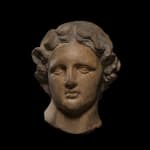Etruscan
An Etruscan terracotta head of a youth, Late 4th - 3rd century BC
Terracotta
Height: 24.1 cm
Further images
Of the Alexander the Great type, the slightly under life-sized, youthful head with idealised facial features and untamed, curly hair.
Of the Alexander the Great type, the slightly under life-sized, youthful head with idealised facial features and untamed, curly hair.
Provenance
With Galerie Simone de Monbrison, Paris, 1982
Literature
The pathos-laden tilt of the head, the youthful, idealised facial features and the untamed, curly hair with strands of hair swept up off the forehead (anastole) recall portraits of Alexander the Great. These types of heads are derived from Hellenistic Greek prototypes and were likely originally part of a full figure.For discussion of a similar example from Capesthorne Hall see C. A. Picón, Classical Antiquities from Private Collections in Great Britain, London, 1986, p. 33, no. 33. A similar head from Calvi (Cales, Campania), now in the British Museum (no. GR 1856.12-26.447), is thought to be a part of a statue that was either a cult image or a votive object, whilst a similar example in the Metropolitan Museum of Art, New York, (acc. no. 11.212.13) is believed to have adorned a pediment. Such terracotta statuary would originally have been painted to look as life-like as possible. The Apollo of Scasato bust in the Villa Giulia still preserves much of its original polychromy which gives a sense of how this head may once have been coloured.







